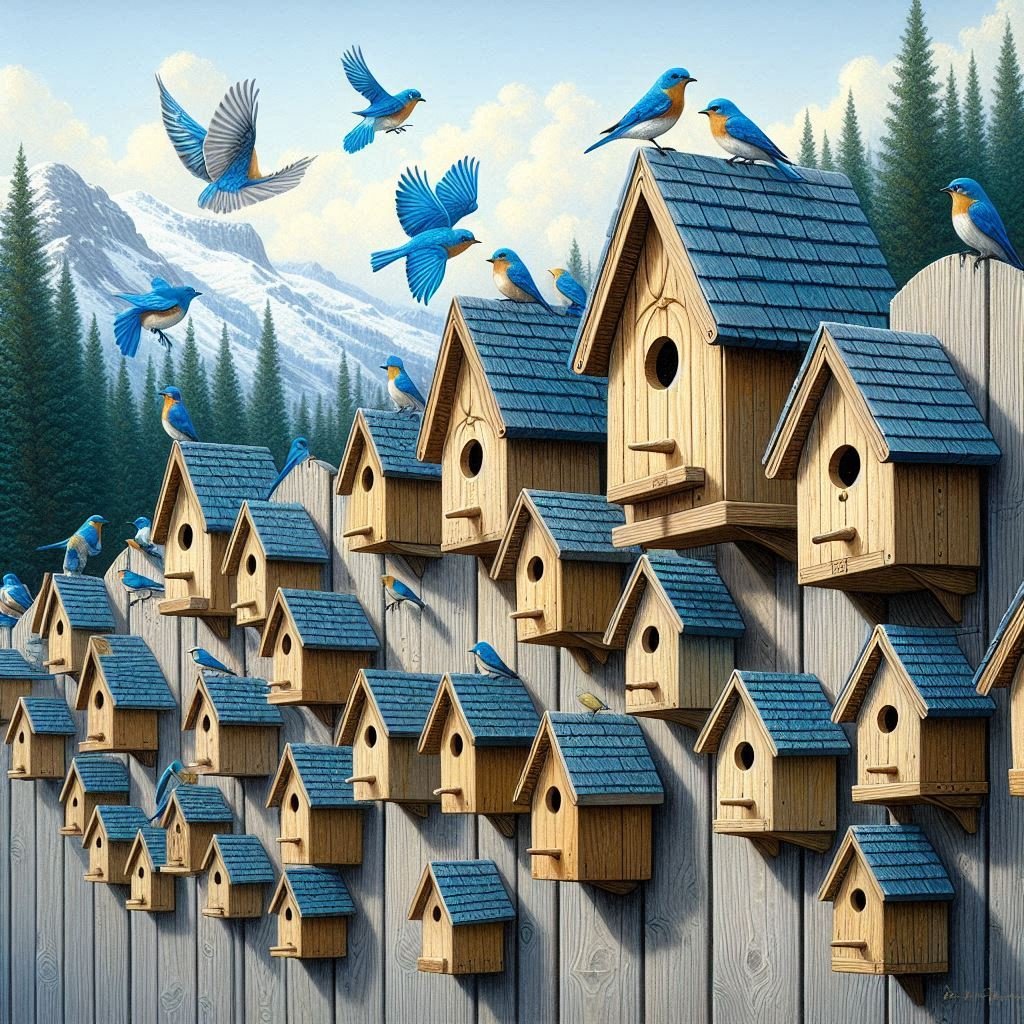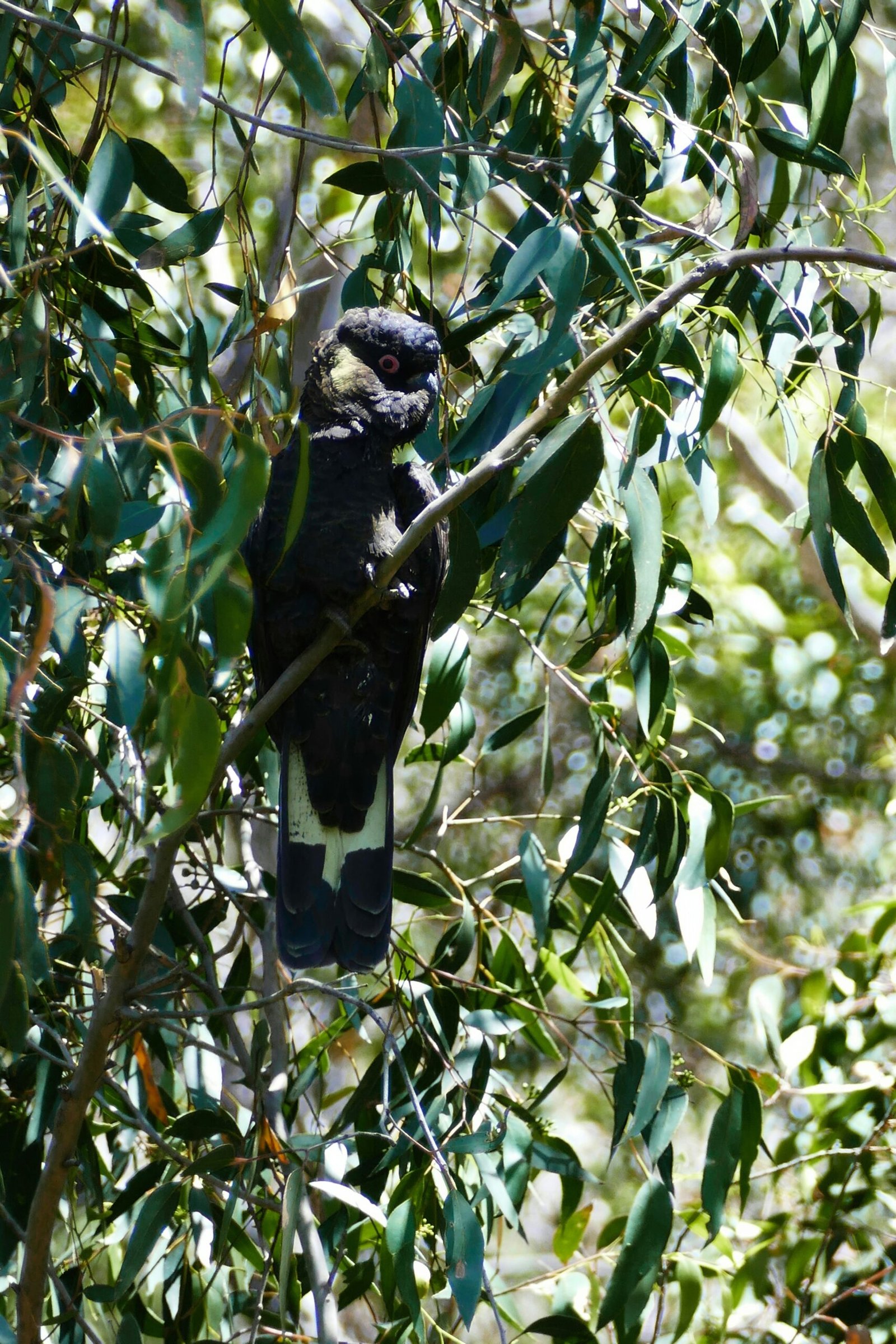Proper spacing of bluebird houses is paramount for attracting these delightful creatures to your yard. Bluebirds are not only admired for their striking beauty but also for their significant role in pest control, consuming large quantities of insects that can damage your garden. By providing suitable nesting sites, you can encourage these beneficial birds to inhabit your space, contributing to a balanced and healthy ecosystem.
A key aspect to successfully attracting bluebirds is ensuring that their houses are appropriately spaced. A general guideline suggests that bluebird houses should be erected at least 100 yards apart. This spacing helps reduce territorial disputes among bluebirds, promoting a more peaceful and thriving environment for them to raise their young.
In this blog post, we will delve into the importance of proper bluebird house spacing and explore expert tips and recommendations to enhance your birdwatching experience. You will learn about the specific needs of bluebirds, the ideal locations for placing their houses, and best practices to ensure their well-being. Whether you are a seasoned bird enthusiast or a novice looking to attract these charming birds to your property, this guide will provide you with valuable insights and practical advice.
Can Bluebird Houses Be Too Close Together?
When it comes to installing bluebird houses, one significant consideration is the spacing between them. Eastern bluebirds are inherently territorial creatures. Placing bluebird houses too close together can lead to heightened aggression and territorial disputes among these birds. This behavior is a natural instinct to protect their nesting area and ensure the survival of their offspring. If their space is encroached upon by neighboring bluebirds, the likelihood of conflict increases, which can have several negative repercussions.
Research has shown that bluebirds prefer to nest at a minimum distance of 100 to 300 feet apart from one another. This spacing helps mitigate aggressive behaviors and ensures each pair has sufficient territory to forage and raise their young successfully. A study conducted by the Cornell Lab of Ornithology highlights that when bluebird houses are placed too closely, stress levels among the birds rise. This stress can manifest in physical altercations, abandonment of nests, and in some cases, even the destruction of eggs or chicks.
For example, a field study published in the Journal of Wildlife Management illustrated that bluebirds with less than 100 feet of space between their nests experienced a 30% decrease in nesting success compared to those with adequately spaced homes. This reduction in nesting success is attributed to the increased competition and stress, leading to fewer eggs being laid and lower chick survival rates.
The negative impacts of overcrowding are not limited to aggression and stress. Overcrowding can also lead to a higher prevalence of disease, as closer proximity facilitates the spread of parasites and pathogens among the birds. This, in turn, affects the overall health and breeding success of bluebird populations.
To ensure bluebirds thrive, it is crucial to adhere to recommended spacing guidelines when installing bluebird houses. Proper spacing reduces conflict, minimizes stress, and promotes healthier and more successful breeding outcomes. For further insights into bluebird behavior and nesting preferences, you may refer to resources such as the North American Bluebird Society and the Audubon Society, which offer comprehensive guidelines and expert opinions on bluebird conservation.
How Far Apart Should I Space Bluebird Houses with Tree Swallows?
The relationship between bluebirds and tree swallows is complex, influenced by their nesting preferences and territorial behaviors. Bluebirds are cavity nesters, often seeking out birdhouses or natural cavities in trees. Tree swallows, similarly, are cavity nesters and frequently compete with bluebirds for the same bluebird nestboxes. Mounting these nestboxes several feet off the ground can help reduce competition. This competition can lead to aggressive interactions, particularly during the breeding season.
To manage this competition, it is crucial to consider the spacing of bluebird houses when tree swallows are present. Research and expert recommendations suggest placing bluebird houses at least 100 yards apart from those intended for tree swallows. This distance helps reduce direct competition and territorial disputes between the two species. Tree swallows are known to be highly territorial and protective of their nesting sites, which underscores the importance of adequate spacing.
An effective strategy to promote coexistence involves setting up paired nest boxes, where one box is intended for bluebirds and the other for tree swallows. These paired boxes should be placed about 5-15 feet apart. This proximity allows both species to establish territories without direct competition for the same box. The bluebirds and tree swallows will each occupy their respective boxes while maintaining a buffer zone that minimizes aggressive encounters.
External sources, such as the North American Bluebird Society and various ornithological studies, support these guidelines. They highlight the importance of understanding the ecological dynamics between these species to foster a harmonious environment. By adhering to the recommended spacing and employing strategies like paired boxes, bird enthusiasts can enhance the nesting success of both bluebirds and tree swallows, contributing to their conservation and enjoyment.
Is It Okay to Have Two Bluebird Houses in My Backyard?
Having multiple bluebird houses in your backyard is both possible and beneficial when done correctly. Bluebirds are territorial creatures, and improper spacing of their houses can lead to disputes and stress among the birds. Therefore, it is crucial to arrange bluebird houses thoughtfully to foster a peaceful cohabitation environment.
Experts recommend spacing bluebird houses at least 100 yards apart. This distance helps to minimize territorial conflicts and ensures that each pair of bluebirds has enough space to forage and nest comfortably. If your backyard is not large enough to accommodate this distance, consider placing one bluebird house in the front yard and another in the back yard or on opposite sides of the property.
When arranging bluebird houses, it is also essential to consider their orientation and whether they are placed on a bluebird trail. Bluebird houses should ideally face an open area, away from prevailing winds and direct sunlight, to keep the nest box cool and protected. Positioning the houses near natural water sources or areas with ample insect activity can also be advantageous, as these are prime feeding grounds for bluebirds. Mounting these on a fence post is often recommended.
For those interested in adding multiple bluebird houses, consulting expert advice can be incredibly helpful. Resources such as the North American Bluebird Society provide comprehensive guidelines and tips on backyard bird housing. These expert recommendations can help ensure that your backyard becomes a safe and welcoming haven for bluebirds.
In conclusion, while it is certainly possible to have two bluebird houses in your backyard, proper spacing and placement are key to creating a harmonious environment. By following expert guidelines and adjusting the arrangement based on your specific yard layout, you can enjoy the presence of multiple bluebird families without the risk of territorial disputes.
What Happens If Bluebird Houses Are Placed Too Close?
Placing bluebird houses too closely together can result in several adverse outcomes for these beautiful avian creatures. One of the most significant issues is the increase in aggressive behavior among bluebirds. When territories overlap, it often leads to intense competition and frequent skirmishes as the birds vie for space, food, and nesting opportunities. Installing a birdhouse can help alleviate some of these conflicts. This territorial aggression can cause significant stress, which may ultimately lower the overall health and well-being of the bluebirds. Providing adequate nestling space can mitigate such issues.
Another consequence of improperly spaced bluebird houses is the disruption of mating and nesting processes. Bluebirds are known to be highly territorial during the breeding season, and close proximity can interfere with their natural mating rituals. This disruption can result in fewer successful pairings and a decline in reproductive success. Nesting within a congested area may also expose the birds to higher risks of predation, as predators can more easily locate and target the densely packed nests.
Lower reproductive success is a notable outcome of overcrowded bluebird habitats. When bluebird houses are too close, there is often an increase in nest abandonment and reduced fledgling survival rates. The increased stress and competition can lead to higher chances of egg damage, lower hatching rates, and fewer surviving chicks. Studies have shown that optimal spacing between bluebird houses contributes to higher reproductive success and healthier populations. For example, research conducted by the North American Bluebird Society highlights that bluebird houses, or bluebird boxes, spaced at least 100 yards apart tend to have better nesting outcomes.
Expert testimonials further underline the importance of proper spacing. Ornithologists and conservationists consistently emphasize that overcrowding can lead to long-term declines in bluebird populations. Case studies from various bluebird conservation projects reveal that maintaining appropriate distances between nesting boxes not only reduces aggressive interactions but also fosters a more stable and thriving environment for these birds.
How Many Bluebird Houses Can I Put on My Property?
Determining the appropriate number of bluebird houses for your property involves several key considerations. The size of your property, the availability of natural resources, and potential threats from predators play crucial roles in making this decision. Experts suggest that spacing bluebird houses at least 100 to 300 feet apart helps reduce territorial disputes and encourages successful breeding.
For example, a property with abundant food sources such as insects and berries, as well as ample nesting materials like grass and pine needles, can support a higher density of bluebird houses. Conversely, properties with limited resources may require fewer houses to prevent competition among the birds. Additionally, the presence of predators like snakes, raccoons, and cats can significantly impact the number of bluebird houses you should install. Implementing predator guards and choosing safe locations for the houses are essential steps in mitigating these risks.
A helpful rule of thumb for calculating the number of bluebird houses is to allow for one house per acre of land, provided that the habitat is conducive to bluebird nesting. This guideline aligns with recommendations from bluebird conservation organizations and habitat studies. For properties smaller than an acre, one house is typically sufficient. Larger properties can accommodate multiple houses, but it’s crucial to ensure proper spacing to avoid territorial conflicts.
In addition to these guidelines, consulting local wildlife experts or bluebird conservation groups can provide tailored advice based on your property’s specific characteristics. Habitat studies have shown that bluebirds thrive in open, grassy areas with scattered trees and minimal underbrush. By creating an environment that meets these criteria and following the spacing recommendations, you can maximize the chances of attracting and supporting a healthy bluebird population on your property.
Where Is the Best Place to Put a Bluebird House in My Yard?
Choosing the optimal location for bluebird houses in your yard is crucial for attracting these beautiful birds and ensuring their safety, especially during the nesting season. One of the primary considerations is sunlight exposure. Bluebirds prefer open areas with plenty of sunlight. Ideally, the bluebird house should be mounted in a spot that receives morning sunlight. This helps keep the nest dry and warm, which is essential for the health of the bluebird chicks. Positioning the birdhouse properly can make a significant difference.
Proximity to trees or shrubs is another important factor. While bluebirds prefer open spaces, having some nearby trees or shrubs can offer essential perching spots for the adult birds. However, the bluebird house should not be too close to dense trees or thick shrubbery, as these areas can harbor predators like snakes or squirrels. A distance of at least 25 to 50 feet from such vegetation is generally recommended.
Predator avoidance is critical when selecting the site for your bluebird house; using a baffle can help protect the nest. Avoid placing the house on fences or low-hanging branches where predators can easily access it. Instead, mount the bluebird house on a metal pole with a predator guard. The pole should be about 4 to 6 feet high, which is the ideal height for bluebirds. Ensure the entrance hole is facing away from prevailing winds to protect the nest from the elements.
Practical tips for mounting and maintaining bluebird houses include regularly cleaning the house to remove old nests and checking for signs of pests. It’s also advisable to monitor the bluebird house throughout the breeding season to ensure it remains secure and safe for the birds.
For detailed, step-by-step guides and visual aids on placing bluebird houses, consider resources such as bird conservation websites or local wildlife organizations. These resources often provide comprehensive instructions and illustrations to help you create the perfect habitat for bluebirds in your yard.
Can Bluebirds Share a Nest Box?
Bluebirds are known for their territorial nature, particularly during the breeding season. Typically, bluebirds do not share a nest box with other bluebirds or different bird species. The primary reason for this behavior is the need to defend their nesting site and resources to ensure the survival of their offspring. However, under certain conditions, bluebirds might exhibit more tolerance towards sharing a nest box.
In rare circumstances, bluebirds may share a nest box, especially if there is an abundance of food and favorable environmental conditions. Such instances are more likely to occur in areas with an ample supply of insects and other food sources, reducing competition. Moreover, some studies have observed that young bluebirds or those without established territories might be more willing to share a nest box temporarily until they can secure their own space.
One potential benefit of nest sharing is increased protection. Bluebirds can collectively defend the nest box from predators and other threats. Additionally, shared parenting responsibilities could potentially lead to higher survival rates for the young. However, these benefits are often outweighed by the drawbacks during the nesting season. Sharing a nest box can lead to increased competition for food and resources, resulting in lower reproductive success for both pairs during the nesting season. Aggressive interactions between bluebirds can also cause stress and injuries, further diminishing the chances of successful breeding.
Expert observations and studies on bluebird behavior reinforce the notion that nest sharing is uncommon. Research conducted by ornithologists, including a study by the North American Bluebird Society, indicates that bluebirds prefer to establish and defend their own territories. These findings are consistent with the general nesting behavior observed among cavity-nesting birds.
For more detailed information on bluebird nest-sharing behavior and related studies, you can explore articles from reputable sources such as the Cornell Lab of Ornithology and the North American Bluebird Society. These resources provide comprehensive insights into the nesting habits and territoriality of bluebirds, helping bird enthusiasts better understand these fascinating creatures and manage their bluebird boxes effectively.
Do Bluebirds Fight Over Nest Boxes?
Bluebirds are known for their territorial nature, particularly during the breeding season. This territoriality often leads to conflicts over nest boxes, as each pair of bluebirds seeks to secure an ideal nesting site. Observations reveal that bluebirds can exhibit aggressive behaviors such as chasing, pecking, and vocal confrontations to defend their chosen territory. These conflicts can sometimes escalate, resulting in physical altercations that may impact nesting success, especially during the nesting season.
Aggressive interactions among bluebirds are primarily driven by their instinct to protect their nesting sites from potential rivals. This behavior ensures that a pair can raise their young in a relatively safe and resource-abundant environment. However, frequent skirmishes can lead to stress and even injury, reducing the likelihood of successful rearing of chicks. Additionally, constant disruptions may force bluebirds to abandon a nest box altogether, leading to a search for alternative sites which may not be as suitable.
To minimize conflicts and enhance nesting success, it is crucial to properly space bluebird houses. Consider placing two boxes at least 100 feet apart. Experts recommend placing nest boxes at least 100 yards apart to reduce the chances of territorial disputes. Providing multiple nest boxes in a given area can also help accommodate more pairs, reducing competition for any single box. Additionally, ensuring that there are ample resources such as food and water sources can further alleviate pressure on nesting bluebirds, promoting a more harmonious environment.
For those interested in observing bluebird interactions and learning more about conflict resolution techniques, there are numerous resources available. Various videos and articles document bluebird behavior and offer insights into effective ways to manage their territorial tendencies. One such resource is the North American Bluebird Society, which provides detailed guidelines and educational materials on bluebird conservation and bluebird nest box management.
How to Deter House Sparrows from Bluebird Houses?
House sparrows, though small, can pose a significant threat to bluebird populations by taking over their nesting spaces. Implementing effective deterrent methods is crucial to ensure bluebirds have a safe environment to thrive. One practical approach is to use specific house designs that are less attractive to house sparrows. For instance, bluebird houses with a deep cavity and a small entrance hole can discourage sparrows from nesting, ensuring more eastern bluebirds can fledge successfully. It is recommended to use entrance hole restrictors, which limit the size of the opening to 1.5 inches in diameter, making it difficult for house sparrows to enter while still accommodating bluebirds.
Another effective strategy is active monitoring of the bluebird houses. Regularly inspect the houses to remove any sparrow nests that may have been built. Be vigilant about monitoring during the breeding season, as house sparrows are known to be persistent nesters. Additionally, installing sparrow spookers—devices with reflective materials that deter sparrows but not bluebirds—can be beneficial. These spookers are particularly effective when placed on the house immediately after the first bluebird egg is laid.
Addressing the issue of house sparrows is essential to protect bluebird populations. House sparrows are aggressive and can harm or even kill bluebirds to take over their nesting sites. By implementing deterrent methods, you are contributing to the conservation efforts for bluebirds and ensuring successful brood rearing. For more detailed guidance on deterring house sparrows, expert guides and specialized products are available. These resources provide comprehensive information and tools designed to help you maintain a safe and conducive environment for bluebirds. This includes advice on mounting birdhouses on fence posts.
In summary, the use of specific house designs, entrance hole restrictors, and active monitoring are key strategies to deter house sparrows from bluebird houses. Protecting bluebird populations requires consistent effort and the right tools, making the implementation of these methods vital.
FAQs
Q: How far apart should bluebird houses be placed to ensure a successful brood?
A: Bluebird houses should ideally be placed at least 100 yards apart to reduce competition among bluebird pairs and ensure successful nesting. This distance helps prevent territorial disputes and encourages a healthy breeding environment.
Q: Can bluebird houses be placed closer together if space is limited?
A: While it is recommended to place bluebird houses at least 100 yards apart, if space is limited, placing them at least 50 yards apart can still provide adequate spacing. However, be prepared for potential competition and reduced nesting success.
Q: What is the optimal height for installing bluebird houses?
A: Bluebird houses should be installed at a height of 4 to 6 feet above the ground. This height helps protect bluebirds from predators and provides an accessible nesting location.
Q: Should bluebird houses face a particular direction?
A: Yes, bluebird houses should ideally face east or southeast. This orientation helps to provide morning sunlight, which warms the nest and can enhance the bluebirds’ comfort and health.
Q: How do I maintain bluebird houses?
A: Regular maintenance is crucial for bluebird houses to ensure the nestbox remains in good condition. Clean the houses at the end of each breeding season to remove old nests and debris. Additionally, check for damage and make necessary repairs to ensure the houses remain safe and inviting for bluebirds.
Q: Are there specific materials that should be used for bluebird houses?
A: Bluebird houses should be made from untreated wood, such as cedar or pine, which provides natural insulation and durability. Avoid using treated wood or metal, as these materials can be harmful to bluebirds.
Q: Can other bird species use bluebird houses?
A: Yes, other bird species, such as tree swallows and chickadees, may use bluebird houses. While this is generally not an issue, monitor the houses to ensure bluebirds are not being outcompeted for nesting space.
For more detailed information on bluebird house placement and maintenance, refer to the relevant sections of our blog post.
Q: How far apart should bluebird houses be to attract eastern bluebirds?
A: To attract eastern bluebirds, bluebird houses should be placed about 100-150 yards apart. Ensuring an appropriate distance helps reduce territorial disputes and increases the chances of a good bluebird population.
Q: What is a bluebird trail, and how can it benefit eastern bluebirds?
A: A bluebird trail is a series of bluebird boxes set up along a specific path or area to provide multiple nesting sites. This can significantly benefit eastern bluebirds by increasing nesting opportunities and contributing to the conservation of the species.
Q: Should bluebird boxes be mounted on conduits?
A: Yes, bluebird boxes should be mounted on electrical conduits or metal poles to prevent predators such as raccoons and snakes from reaching inside the box. Conduits provide a stable and safer structure for the birdhouses.
Q: Can western bluebirds and mountain bluebirds use the same type of nestbox as eastern bluebirds?
A: Yes, western bluebirds and mountain bluebirds can use the same type of nestbox as eastern bluebirds. However, it’s important to place these boxes in appropriate habitats suited for each species to encourage nesting.
Q: How often should I monitor bluebird boxes during the nesting season?
A: It’s recommended to monitor bluebird boxes at least once a week during the nesting season. Regular monitoring allows for early detection of issues such as starling or house wren invasions and helps ensure the safety and well-being of the nesting bluebirds.
Q: What direction should bluebird boxes face?
A: Bluebird boxes should ideally face east or southeast. This orientation helps keep the nestbox warmer in the morning and cooler in the afternoon, providing a good environment for bluebirds to nest and raise their young.
Q: How high should bluebird boxes be mounted?
A: Bluebird boxes should be mounted 4 to 6 feet above the ground. This height is optimal for bluebirds and reduces the risk of predation while also allowing for easier monitoring and maintenance.
Q: What should I do if I find house wrens or starlings in a bluebird box?
A: If you find house wrens or starlings in a bluebird box, it’s essential to take action to protect the bluebirds. Removing the nest materials of these invasive species and relocating the box can help discourage them and give bluebirds a better chance to nest.
Q: How can I ensure a safe environment for bluebirds inside the box?
A: To ensure a safe environment for bluebirds inside the box, use predator guards such as baffles, monitor for ants or other pests, and clean out old nests after the bluebirds leave the nest. Additionally, make sure the entry hole is appropriately sized to deter invasive species and provide a secure nesting site.
Q: What should I do if bluebirds leave the box during nesting?
A: If bluebirds leave the box during nesting, check for possible disturbances such as predators, pests, or human interference. Resolving these issues and providing a quiet and safe spot for the young bluebirds can encourage them to return or find another suitable nesting site nearby.
Conclusion
The proper spacing of bluebird houses is crucial to fostering healthy and thriving bluebird populations throughout the nesting season. Throughout this blog post, we have discussed several key points that underline the importance of appropriate placement. Ensuring that bluebird houses are adequately spaced helps minimize territorial conflicts, reduces stress on the birds, and enhances their chances of successful nesting and rearing of chicks. Installing a feeder nearby can further support their needs.
Additionally, we have highlighted the recommended distance between bluebird houses, which generally ranges from 100 to 300 feet apart, depending on the species and environmental conditions. This spacing allows bluebirds to establish their territories while maximizing their natural habitats. By adhering to these guidelines, bird enthusiasts can contribute significantly to the conservation efforts for these charming songbirds.
We encourage you to implement the tips and guidelines provided in this post to create a welcoming and safe environment for bluebirds in your area. Properly spaced bluebird houses not only support the well-being of the birds but also enhance your chances of witnessing their fascinating behaviors and beautiful songs up close.
For further information and additional resources on bluebird conservation, consider subscribing to our newsletter. You will receive regular updates, expert advice, and valuable insights into birdwatching and habitat management. Also, feel free to visit the linked external resources for more detailed guidance and support from reputable organizations dedicated to bird conservation.
By taking these steps, you can play a pivotal role in ensuring that bluebird populations continue to flourish, bringing joy and natural beauty to our surroundings.







